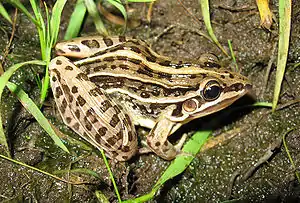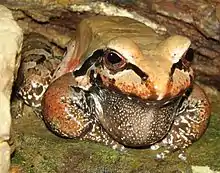Pfeiffrösche
Die Pfeiffrösche (Leptodactylidae im engeren Sinn) sind eine neuweltlich verbreitete Familie der Froschlurche (Anura). Bis vor einiger Zeit wurde diese wesentlich weiter gefasst. Dabei handelte es sich allerdings um ein paraphyletisches Sammeltaxon, das im Deutschen unter den Namen Südfrösche oder auch Pfeiffrösche bekannt war. Die meisten dieser ehemals weit über 1000 Arten wurden nach umfassenden Revisionen in anderen Familien klassifiziert (vgl. Ceratophryidae, Cycloramphidae, Alsodidae, Eleutherodactylidae, Telmatobiidae und Craugastoridae).
| Pfeiffrösche | ||||||||||||
|---|---|---|---|---|---|---|---|---|---|---|---|---|

Leptodactylus gracilis | ||||||||||||
| Systematik | ||||||||||||
| ||||||||||||
| Wissenschaftlicher Name | ||||||||||||
| Leptodactylidae | ||||||||||||
| Werner, 1896 |
Die verbliebenen 13 Gattungen der Leptodactylidae im engeren Sinn kommen mit mehr als 200 Arten vom äußersten Süden von Texas bis ins südliche Brasilien vor. Die bei weitem artenreichste Gattung sind die Echten Pfeiffrösche (Leptodactylus) mit 74 Arten. Ihre Vertreter verfügen oft über laute, pfeifende Rufe. Bei der Fortpflanzung wird der Laich in ein selbst fabriziertes Schaumnest gelegt. Dies geschieht meistens in einem Gewässer oder in Gewässernähe, beim brasilianischen Marmor-Pfeiffrosch (Adenomera marmorata, Syn. Leptodactylus marmoratus) wird das Schaumgelege jedoch im Erdboden vergraben, wo die Kaulquappen auch ihre gesamte Entwicklung durchlaufen.
Gattungen und Arten

Die Familie umfasst drei Unterfamilien mit 13 Gattungen mit insgesamt 206 Arten.
(Bearbeitungsstand: 4. Januar 2021)
Unterfamilie Leptodactylinae Werner 1896 (103Arten) Stand: 23. Juni 2020
- Gattung Adenomera Steindachner, 1867 (21 Arten) Stand: 23. Juni 2020
- Adenomera ajurauna (Berneck, Costa & Garcia, 2008)
- Adenomera andreae (Müller, 1923)
- Adenomera araucaria Kwet & Angulo, 2002
- Adenomera bokermanni (Heyer, 1973)
- Adenomera chicomendesi Carvalho, Angulo, Kokubum, Barrera, Souza, Haddad & Giaretta, 2019[1]
- Adenomera coca (Angulo & Reichle, 2008)
- Adenomera cotuba Carvalho & Giaretta, 2013
- Adenomera diptyx (Boettger, 1885)
- Adenomera engelsi Kwet, Steiner & Zillikens, 2009
- Adenomera glauciae Carvalho, Simões, Gagliardi-Urrutia, Rojas-Runjaic, Haddad & Castroviejo-Fisher, 2020[2]
- Adenomera guarayo Carvalho, Angulo, Barrera, Aguilar-Puntriano & Haddad, 2020[3]
- Adenomera heyeri Boistel, Massary & Angulo, 2006
- Adenomera hylaedactyla (Cope, 1868)
- Adenomera juikitam Carvalho & Giaretta, 2013
- Adenomera kweti Carvalho, Cassini, Taucce & Haddad, 2019[4]
- Adenomera lutzi Heyer, 1975
- Adenomera marmorata Steindachner, 1867
- Adenomera martinezi (Bokermann, 1956)
- Adenomera nana (Müller, 1922)
- Adenomera phonotriccus Carvalho, Giaretta, Angulo, Haddad & Peloso, 2019[5]
- Adenomera saci Carvalho & Giaretta, 2013
- Adenomera simonstuarti (Angulo & Icochea, 2010)
- Adenomera thomei (Almeida & Angulo, 2006)
- Gattung Hydrolaetare Gallardo, 1963 (3 Arten) Stand: 23. Juni 2020
- Hydrolaetare caparu Jansen, Gonzales-Álvarez & Köhler, 2007
- Hydrolaetare dantasi (Bokermann, 1959)
- Hydrolaetare schmidti (Cochran & Goin, 1959)
- Gattung Leptodactylus Fitzinger, 1826 – Echte Pfeiffrösche Stand: 23. Juni 2020
- 78 Arten
- Gattung Lithodytes Fitzinger, 1843 Stand: 23. Juni 2020
- einzige Art: Lithodytes lineatus (Schneider, 1799)
Die Gattung Lithodytes wurde weitgehend aufgelöst und auf mehrere andere Taxa verteilt. Zumindest die Art Lithodytes lineatus wird in manchen Übersichten aber als valide betrachtet (sonst als Synonym von Leptodactylus lineatus).
Unterfamilie Paratelmatobiinae Ohler & Dubois, 2012 (13 Arten)
- Gattung Crossodactylodes Cochran, 1938 (5 Arten)
- Crossodactylodes bokermanni Peixoto, 1983
- Crossodactylodes itambe Barata, Santos, Leite & Garcia, 2013
- Crossodactylodes izecksohni Peixoto, 1983
- Crossodactylodes pintoi Cochran, 1938
- Crossodactylodes septentrionalis Teixeira, Recoder, Amaro, Damasceno, Cassimiro & Rodrigues, 2013
- Gattung Paratelmatobius Lutz & Carvalho, 1958 (6 Arten)
- Paratelmatobius cardosoi Pombal & Haddad, 1999
- Paratelmatobius gaigeae (Cochran, 1938)
- Paratelmatobius lutzii Carvalho in Lutz & Carvalho, 1958
- Paratelmatobius mantiqueira Pombal & Haddad, 1999
- Paratelmatobius pictiventris Lutz in Lutz & Carvalho, 1958
- Paratelmatobius poecilogaster Giaretta & Castanho, 1990
- Gattung Rupirana Heyer, 1999 (1 Art)
- einzige Art: Rupirana cardosoi Heyer, 1999
- Gattung Scythrophrys Lynch, 1971 (1 Art)
- einzige Art: Scythrophrys sawayae (Cochran, 1953)
Unterfamilie Leiuperinae Bonaparte, 1850 (100 Arten) Stand: 23. Juni 2020
- Gattung Edalorhina Jiménez de la Espada, 1870 (2 Arten) Stand: 23. Juni 2020
- Edalorhina nasuta Boulenger, 1912
- Edalorhina perezi Jiménez de la Espada, 1870
- Gattung Engystomops Jiménez de la Espada, 1872 (9 Arten) Stand: 23. Juni 2020
- Engystomops coloradorum (Cannatella & Duellman, 1984)
- Engystomops freibergi (Donoso-Barros, 1969)
- Engystomops guayaco (Ron, Coloma & Cannatella, 2005)
- Engystomops montubio (Ron, Cannatella & Coloma, 2004)
- Engystomops petersi Jiménez-de-la-Espada, 1872 (Typusart)
- Engystomops pustulatus (Shreve, 1941)
- Engystomops pustulosus (Cope, 1864) Tungara-Frosch
- Engystomops puyango Ron, Toral, Rivera & Terán-Valdez 2010
- Engystomops randi (Ron, Cannatella & Coloma, 2004)
- Gattung Lidblasenfrösche (Physalaemus) Fitzinger, 1826 Stand: 23. Juni 2020
- 49 Arten, darunter Physalaemus spiniger
- Gattung Pleurodema Tschudi, 1838 (15 Arten) Stand: 18. Juni 2018
- Pleurodema alium Maciel & Nunes, 2010
- Pleurodema bibroni Tschudi, 1838
- Pleurodema borellii (Peracca, 1895)
- Pleurodema brachyops (Cope, 1869)
- Pleurodema bufoninum Bell, 1843
- Pleurodema cinereum Cope, 1878
- Pleurodema cordobae Valetti, Salas & Martino, 2009
- Pleurodema diplolister (Peters, 1870)
- Pleurodema guayapae Barrio, 1964
- Pleurodema kriegi (Müller, 1926)
- Pleurodema marmoratum (Duméril & Bibron, 1840)
- Pleurodema nebulosum (Burmeister, 1861)
- Pleurodema somuncurense (Cei, 1969)
- Pleurodema thaul (Schneider, 1799)
- Pleurodema tucumanum Parker, 1927
- Gattung Pseudopaludicola Miranda-Ribeiro, 1926 (26 Arten)[6] Stand: 7. Juli 2020
- Pseudopaludicola atragula Pansonato et al., 2014[7]
- Pseudopaludicola ameghini (Cope, 1887)
- Pseudopaludicola boliviana Parker, 1927
- Pseudopaludicola canga Giaretta & Kokubum, 2003
- Pseudopaludicola ceratophyes Rivero & Serna, 1985
- Pseudopaludicola coracoralinae Andrade, Haga, Lyra, Carvalho, Haddad, Giaretta & Toledo, 2020[8]
- Pseudopaludicola facureae Andrade & Carvalho, 2013[9]
- Pseudopaludicola falcipes (Hensel, 1867)
- Pseudopaludicola florencei Andrade, Haga, Lyra, Leite, Kwet, Haddad, Toledo & Giaretta, 2018[10]
- Pseudopaludicola giarettai Carvalho, 2012
- Pseudopaludicola hyleaustralis Pansonato, Morais, Ávila, Kawashita-Ribeiro, Strussmann & Martins, 2012
- Pseudopaludicola ibisoroca Pansonato, Veiga-Menoncello, Mudrek, Jansen, Recco-Pimentel, Martins & Strüssmann, 2016[11]
- Pseudopaludicola jaredi Andrade, Magalhães, Nunes-de-Almeida, Veiga-Menoncello, Santana, Garda, Loebmann, Recco-Pimentel, Giaretta & Toledo, 2016[12]
- Pseudopaludicola jazmynmcdonaldae Andrade, Silva, Koroiva, Fadel & Santana, 2019[13]
- Pseudopaludicola llanera Lynch, 1989
- Pseudopaludicola mineira Lobo, 1994
- Pseudopaludicola motorzinho Pansonato, Veiga-Menoncello, Mudrek, Jansen, Recco-Pimentel, Martins & Strüssmann, 2016[11]
- Pseudopaludicola murundu Toledo, Siqueira, Duarte, Veiga-Menoncello, Recco-Pimentel & Haddad, 2010
- Pseudopaludicola mystacalis (Cope, 1887)
- Pseudopaludicola parnaiba Robert, Cardozo & Ávila, 2013
- Pseudopaludicola pocoto Magalhães, Loebmann, Kokubum, Haddad & Garda, 2014[14]
- Pseudopaludicola pusilla (Ruthven, 1916)
- Pseudopaludicola restinga Cardozo, Baldo, Pupin, Gasparini & Haddad, 2018[15]
- Pseudopaludicola saltica (Cope, 1887)
- Pseudopaludicola ternetzi Miranda-Ribeiro, 1937
- Pseudopaludicola serrana Toledo, 2010 wurde 2014 mit Pseudopaludicola murundu Toledo, Siqueira, Duarte, Veiga-Menoncello, Recco-Pimentel & Haddad, 2010 synonymisiert.
- Der Vorschlag, Pseudopaludicola parnaiba Robert, Cardozo & Ávila, 2013 mit Pseudopaludicola canga Giaretta & Kokubum, 2003 zu synonymisieren,[8] wurde jedoch weder in Amphibian Species of the World (ASW)[16] noch in Amphibiaweb (AW)[17] umgesetzt.
Einzelnachweise
- T. R. de Carvalho, A. Angulo, M. N. de C. Kokubum, D. A. Barrera, M. B. de Souza, C. F. B. Haddad & A. A. Giaretta: A new cryptic species of the Adenomera andreae clade from southwestern Amazonia (Anura, Leptodactylidae). Herpetologica 75, S. 233–246, 2019.
- T. R. de Carvalho, P. I. Simões, L. A. G. Gagliardi-Urrutia, F. J. M. Rojas-Runjaic, C. F. B. Haddad & S. Castroviejo-Fisher: A new forest-dwelling frog species of the genus Adenomera (Leptodactylidae) from northwestern Brazilian Amazonia. Copeia, 108, S. 924–937, 2020
- T. R. de Carvalho, A. Angulo, D. A. Barrera, C. Aguilar-Puntriano & C. F. B. Haddad: Hiding in plain sight: A fourth new cryptic species of the Adenomera andreae Clade (Anura: Leptodactylidae) from southwestern Amazonia. Herpetologica, 76, S. 304–314, 2020
- T. R. de Carvalho, C. S. Cassini, P. P. G. Taucce & C. F. B. Haddad: A new, morphologically cryptic species of Adenomera closely related to Adenomera araucaria from the Atlantic Forest of southern Brazil (Anura, Leptodactylidae). Journal of Herpetology, 53, S. 131–143, 2019
- T. R. de Carvalho, A. A. Giaretta, A. Angulo, C. F. B. Haddad & P. L. V. Peloso: A new Amazonian species of Adenomera (Anura: Leptodactylidae) from the Brazilian state of Pará: a tody-tyrant voice in a frog. American Museum Novitates, 3919, S. 1–21, 2019
- Darrel R. Frost: Leptodactylidae Werner, 1896 (1838). Amphibian Species of the World: an Online Reference. Version 6.0. American Museum of Natural History, New York, 1998–2020, abgerufen am 15. Juli 2020.
- André Pansonato, Jessica Rheiza Mudrek, Ana Cristina Prado Veiga-Menoncello, Denise de Cerqueira Rossa-Feres, Itamar Alves Martins & Christine Strüssmann: A new specides of Pseudopaludicola Miranda-Ribeiro, 1926 (Anura: Leptodactylidae: Leiuperinae) from northwestern state of Sao Paulo, Brazil. Zootaxa, 3861, 3, Seiten 249–264, September 2014
- Felipe Silva de Andrade Andrade, Isabelle Aquemi Haga, Mariana Lúcio Lyra, Thiago Ribeiro de Carvalho, Célio Fernando Babtista Haddad, Ariovaldo Antonio Giaretta & Luís Felipe Toledo: Reassessment of the taxonomic status of Pseudopaludicola parnaiba (Anura, Leptodactylidae, Leiuperinae), with the description of a new cryptic species from the Brazilian Cerrado. European Journal of Taxonomy, 679, S. 1–36, 2020 doi:10.5852/ejt.2020.679
- Felipe Silva de Andrade & Thiago Ribeiro de Carvalho: A new species of Pseudopaludicola Miranda-Ribeiro (Leiuperinae: Leptodactylidae: Anura) from the Cerrado of southeastern Brazil. Zootaxa, 3608, 5, S. 389–397, 2013.
- Felipe Silva de Andrade, Isabelle Aquemi Haga, Mariana Lúcio Lyra, Felipe Sá Fortes Leite, Axel Kwet, Célio Fernando Babtista Haddad, Luís Felipe Toledo & Ariovaldo Antonio Giaretta: A new species of Pseudopaludicola Miranda-Ribeiro (Anura: Leptodactylidae: Leiuperinae) from eastern Brazil, with novel data on the advertisement call of Pseudopaludicola falcipes (Hensel). Zootaxa, 4433, S. 71–100, 2018.
- André Pansonato, Ana Cristina Prado Veiga-Menoncello, Jessica Rheiza Mudrek, M. Jansen, S. M. Recco-Pimentel, Itamar Alves Martins & Christine Strüssmann: Two new species of Pseudopaludicola (Anura: Leptodactylidae: Leiuperinae) from eastern Bolivia and western Brazil. Herpetologica, 72, S. 235–255, 2016
- Felipe Silva de Andrade, F. de M. Magalhães, C. H. L. Nunes-de-Almeida, Ana Cristina Prado Veiga-Menoncello, D. J. Santana, A. A. Garda, D. Loebmann, S. M. Recco-Pimentel, Ariovaldo Antonio Giaretta, L. F. Toledo: A new species of long-legged Pseudopaludicola from northeastern Brazil (Anura, Leptodactylidae, Leiuperinae). Salamandra, 52, S. 107–124, 2016
- F. S. de Andrade, L. Alves da Silva, R. Koroiva, R. M. Fadel & D. J. Santana: A new species of Pseudopaludicola Miranda-Ribeiro, 1926 (Anura: Leptodactylidae: Leiuperinae) from an Amazonia-Cerrado transitional zone, state of Tocantins, Brazil. Journal of Herpetology, 53, S. 68–80, 2019
- F. de M. Magalhães, D. Loebmann, M. N. de C. Kokubum, Célio Fernando Babtista Haddad, A. A. Garda: A new species of Pseudopaludicola (Anura: Leptodactylidae: Leiuperinae) from northeastern Brazil. Herpetologica, 70, S. 77–88, 2014
- D. Cardozo, D. Baldo, N. Pupin, J. L. Gasparini & Célio Fernando Babtista Haddad: A new species of Pseudopaludicola (Anura, Leiuperinae) from Espírito Santo, Brazil. PeerJ 6 (e4766), S. 1–25, 2018.
- Darrel R. Frost: Pseudopaludicola Miranda-Ribeiro, 1926. Amphibian Species of the World: an Online Reference. Version 6.0. American Museum of Natural History, New York, 1998–2020, abgerufen am 16. Juli 2020.
- Leptodactylidae. Amphibiaweb, abgerufen am 15. Juli 2020.
Literatur
- Günther E. Freytag, Bernhard Grzimek, Oskar Kuhn & Erich Thenius (Hrsg.): Lurche. In: Grzimeks Tierleben, Bd. 5: Fische 2, Lurche. Lizenzausgabe im dtv, München 1980, ISBN 3-423-03204-9
Weblinks
- Darrel R. Frost: Leptodactylidae Werner, 1896 (1838). Amphibian Species of the World: an Online Reference. Version 6.0. American Museum of Natural History, New York, 1998–2020, abgerufen am 15. Juli 2020.
- Leptodactylidae. Amphibiaweb, abgerufen am 15. Juli 2020.